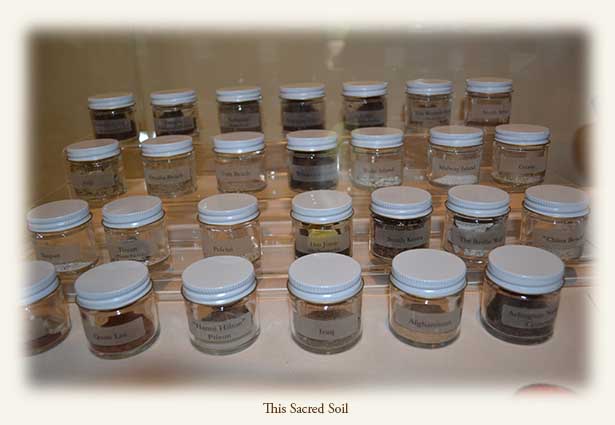The Grapevine Art & Soul Salon

Tracking History: Jonathan Knott, Host
Sacred Soil
A few months ago, the Atlanta History Center opened a new outdoor memorial to the five branches of the U.S. military forces. The theme of the memorial involves "sacred soil" and contains samples of soil collected from every major battlefield the U.S. has ever fought on, much of it donated by veterans from all over the country. Two-thirds of the soil is buried under markers in the memorial, and one-third of it is presented in little marked jars on a display inside the History Center. The soil samples range from early battles in the Revolutionary War all the way up to recent ones in Iraq and Afghanistan, and finally a sample from Arlington National cemetery as well. It's a small display that at first glance looks like nothing more impressive than someone's spice rack until you contemplate the hundreds of thousands of lives lost and millions more affected by the conflicts involved.
But why soil? Why not buttons, or spent bullets, or any number of countless other objects left over from war? What makes a handful of dirt or sand so significant? It likely wouldn't have mattered so much to people until we began cultivating land about 10,000 years ago when soil became a symbol of what sustains us. It's what we grow our food in, what produces nutrients and plants, what we're buried in when we die. It's the beginning and the end of our lives; the continuous cycle.
Early on, we as Americans fought to keep England from taxing our work on our land (that is, the land we took from the Native Americans to whom it was also sacred) when they themselves lived in another land. I contend that in the Civil War, one of the reasons the Southern fighting man had an advantage was that the land in the South, an agrarian society, was in large part more important to the people than land was in the industrialized north. The land itself represented a way of life being threatened.
In World War I, when technology made weapons more terrible than most people could comprehend, soldiers on both sides dug trenches and bunkers down deep in the earth to live in with some level of safety and security. Those enormous weapons were then turned upon the land itself, and millions upon millions of artillery shells (sometimes that many in just a few days) were used to pound the earth, to destroy shelter and drive insane those who didn't die outright. Whole forests full of trees that had been there for hundreds of years were torn up by their ancient roots and left as barren wastelands marked by craters where once life flourished. But many of those same fields have grown lush again now, are full of new trees and quiet life. Land itself cannot be conquered. We learned this in Vietnam and Afghanistan, where people with stone age technology held off the mightiest armies in the world by going deeper into the earth's resources than in WWI, by using their familiarity with the land to break us upon the rocks like a wave of water, emerging refreshed and ready for another round of battle as our vaunted technology failed to defeat the earth itself.
There is something sacred about the blood that's spilled on soil, as if we have given something of our essence back to the substance from which we were birthed and nourished, nourishing it in turn with the most precious thing we have to give of ourselves. Contemplating this while looking at the little jars of earth taken from places where so many spilled their blood, some of whom survived and some not, is an experience that is perhaps best described as "grounding."

TRACKING HISTORY ARCHIVES
Copyright 2014, Barbara Knott. All Rights Reserved.